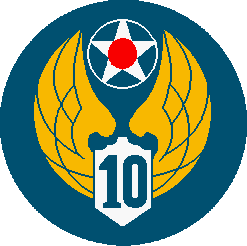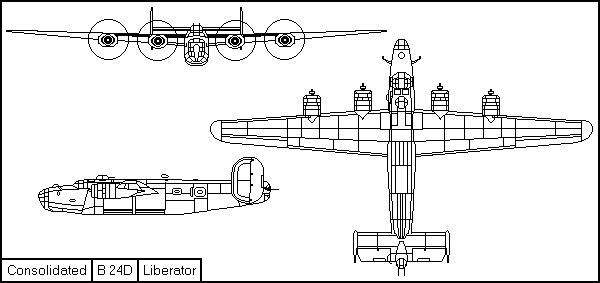 | CONSOLIDATED B24 LIBERATOR |  |
 | CONSOLIDATED B24 LIBERATOR |  |

| MODEL | LB-30 | B-24D | B-24J | B-24L | B-24M |
| WING SPAN |
110' | 110' | 110' | 110' | 110' |
| LENGTH | 66'4" | 66'4" | 67'75/8" | 67'33/16" | 67'33/16" |
| POWER | 4 P&W R-1830-61 1200 hp | 4 P&W R-1830-43 1200 hp | 4 P&W R-1830-65 1200 hp | 4 P&W R-1830-65 1200 hp | 4 P&W R-1830-65 1200 hp |
| ARMAMENT | 8 .50 Cal Browning MG | 8-10 .50 Cal Browning MG | 10 .50 Cal Browning MG | 10 .50 Cal Browning MG | 10 .50 Cal Browning MG |
| EMPTY WEIGHT (Lbs) |
32,050 | 37,000 | 38,000 | 37,500 | 37,500 |
| GOMBAT WEIGHT (Lbs) |
41,000 | 56,000 | 56,000 | 56,000 | 56,000 |
| TOP SPEED (Mph) |
313 | 303 | 290 | 290 | 290 |
| CRUISING SPEED (Mph) |
160 | 175 | 214 | 214 | 214 |
| MAXIMUM RANGE (Miles) |
3,650 | 3,500 | 3,300 | 3,300 | 3,300 |
| CEILING (Feet) |
34,000 | 32,000 | 28,000 | 28,000 | 28,000 |
| CREW | 8 | 8-9 | 10 | 10 | 10 |
In the summer of 1937 Reuben H. Fleet, president of Consolidated Aircraft met with David R. Davis. Davis was a freelance aeronautical engineer, and he was pitching a wing that was different from any ever seen before to Consolidated for use on their new flying boat design. Fleet was not impressed with Davis' wing design, a long, narrow chord, thick shoulder design that Davis claimed gave appreciably better performance than any then in use, nor was Consolidated's cheif engineer, I. M. Laddon, and Davis was sent on his way. A few days leter, however, Laddon told Fleet that he had a hunch that Davis just might be on to something with his wing, and Fleet dubiously agreed to pay for construction of a model and a wind tunnel test at the California Institute of Technology. They would give Davis a chance at designing a wing for their new flying boat, and then test it against their own design, one which they felt was near the ultimate for aircraft of that type.
The results of the wind tunnel test were unbelievable, so much so that Cal Tech recalibrated their wind tunnel and ran them a second time, and then a third time. When they delivered their report to Consolidated it indicated that Mr Davis's wing might just be everything it was claimed to be and more, or that it could be a wind tunnel fluke, something that only gave the results it did in the tunnel. After considerable thought Fleet decided to gamble that the wing was indeed what it was claimed to be and it was decided that it would be used on Consolidated's new twin engine flying boat, the Model 31.
As work proceeded on the Model 31 throughout 1938, the U.S. Army, with an eye on the growing possibility of war in Europe, asked Consolidated to consider becoming a second source of production for the Boeing B-17. Personnel from the San Diego plant went to Seattle to study the idea, but Consolidated rejected it on the grounds that the B-17 design was incomplete and that it would be hard to adapt the design to Consolidated's building methods. What Consolidated had in mind was far more ambitious; the production of an entirely new four engine bomber design.
Early in January, 1939 Fleet called designer Frank W. Fink into his office, where Fleet and Laddon told him they had decided that Consolidated would build a better bomber than Boeing's B-17, and in as short a time as it would take to become a second source for the B-17. They informed Fink that he was to be project engineer for the new design and that a wooden mockup was to be ready in two weeks time. When Fink asked what the new bomber looked like, which proposal Consolidated had been working on he was to do the mock up for, he was informed that no proposal or drawing existed, this was to be a completely new project. Fink was then given a verbal description of the new bomber: he was to use the Davis wing from the Model 31, the twin tail from the Model 31, four engine nacelles from the PBY Catalina, and build a new fuselage containing two bomb bays, each as large as the single bomb bay of the B-17 for his mock up, and he had 14 days in which to build it as Fleet and Laddon were about to leave for Wright Field to pitch their new bomber to the U.S. Army.
The wooden mock up of Consolidated's new bomber was completed on time and an Army board appointed to take a look at it. In order to satisfy procurement regulations a U.S. Army Air Corps Type Specification was drawn up and this was circulated to the Glen L. Martin Company and Sikorsky Aviation Corporation for possible designs meeting the specifications. Since less than 21 days were allowed for reply this was merely a gesture, and on February 21, the Consolidated proposal was recommended to Washington for approval. A formal contract was signed on March 30, 1939 and work proceeded on the aircraft which had officially become the Model 32, to be completed by December 30, 1939.
As work began on the Model 32, the Model 31 program was completed, with the first flight being made on May 5, 1939. The report from Consolidated's chief test pilot, William Wheatly left no doubt that Fleet's gamble with the Davis wing had paid off, and Consolidated's design team proceeded with no misgivings in regard to the aereodynamics of the wing and tail empennage, as those had been borrowed directly from the Model 31. The XB-24, as the Army had designated the air craft made it's maiden flight on December 29, 1939, one day under deadline.
By the time the XB-24 first flew the war in Europe had begun. Both the British and the French were searching for a high speed long range bomber, and the B-24 fit the bill to a "T". The French ordered 175 of the machines, and the British ordered 165. Before any of the machines destined for France could be manufactured, however, France surrendered to Germany, and the bulk of their order was taken over by the British. These first machines, now nicknamed the "Liberator", were designated as LB-30's (LB standing for Land Bomber), with the first 6 being allocated to the Noprth Atlantic Ferry route, and the bulk going to RAF Coastal Command for anti-submarine patrol duties.
By the time of the Japanese attack on Pearl harbor, the B-24 was just begining to enter service in the USAAF. It had been planned that two B-24's would be used on a special mission to photograph Japanese installations on the atolls of Truk, Jaluit and Ponape while ostensibly enroute to the Phillipines, but the attack on US military installations in Hawaii rendered the plan impossible, and destroyed one of the aircraft where it sat outside a hanger at Hickam Field making the B-24 the first USAAF heavy bomber lost to enemy action in World War II.
In combat the greater range, speed and load carrying capacity of the B-24 quickly showed to great advantage, and the "Liberator" became the preferred heavy bomber in most theaters. The differences in the speed and load carrying capacity between the B-24 and B-17 were so great in fact, that it was planned that it would become the only heavy bomber used in all but the 8th Air Force in England, where the B-17 predominated from the outset. While this plan was put into effect in the Asia-Pacific Theater of Operations, it was never fully realized in the European Theater, where the 15th Air Force maintained 6 bomb groups using the B-17 out of a total of 21, and the 8th Air Force still had 12 of its ## groups using the "Liberator" when the war ended in May, 1945.
In addition to being faster and able to carry heavier loads than the B-17, the B-24 also proved to be more versatile, it's cavernous bomb bays and box like fuselage leant itself to a variety of uses. Transport and tanker versions of the B-24 appeared in short order, designated C-87 and C-109 respectively and the majority of these were used to ferry gasoline and supplies over the Himalayas to supply the 14th Air Force. Specially modified C-87's were used as personal transport by Winston Churchill, and built for use by President Roosevelt, though Roosevelt never actually flew in the one built for him. A special version, designated PB4Y-2, was built for the U.S. Navy. The PB4Y-2 featured a single tail rather than the Liberator's twin tails, a flight deck with a 7 foot stretch in it to accommodate extra electronic gear, twin power turrets in the waist positions, two dorsal turrets rather than the one of the Liberator, and a ball turret in the nose. This version was used as a combination long range patrol bomber and fighter, accounting for a large number of Japanese bomber and transport aircraft. In addition to the above, a limited number of B-24's were modified for use in phtographic reconnaissane work. Designated as F-7's, they featured special cameras mounted in the nose and forward bomb bay, with the aft bomb bay converted into a control station where the camera operator sat. By war's end a total of 19, 256 B-24's and B-24 variants were produced, making it the most produced U.S. aircraft of the war. Today only 22 survive in various states of preservation.
Aircraft |
Links |
Library |
Sections |
Units |